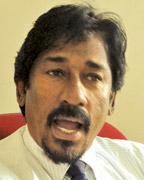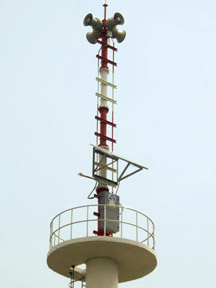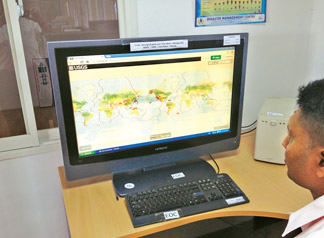Are we prepared to face natural disasters?
Landslides due to man-made causes - NBRO:
More risk management steps undertaken - DMC:
By Kurulu Kariyakarawana
|

Deputy Director
Media DMC Lal Sarath
Kumara
|
Managing natural disasters has become a crucial factor for countries
almost in any region today. Preparing and gearing up for earthquakes,
tsunamis, cyclones and tornadoes is practised frequently not only to
minimise the casualties but also looking at the high rate of such
disasters being reported in the recent past.
Apart from the number of casualties reported in these incidents the
amount of damage done to the property and the economic loss cannot be
underestimated either. A recent report by the United Nations Office for
Disaster Risk Reduction (UNISDR) warns huge losses possible in the Asian
region following natural disasters if the private sector does not focus
on disaster risk management along with its business investment
strategies.
2013 Global Assessment Report on Disaster Risk Reduction emphasise on
the fact that private sector investment decisions will determine as to
how safe the region will be.
With trillions of dollars being invested in hazard-prone coasts and
cities of Asia in the coming years could generate a greater risk as more
population and more economic assets in hazard-prone areas mean more risk
and bigger disasters.
It is estimated average annual direct losses from earthquakes is at
$100billion globally and 76 percent of it will be in Asia and average
annual direct losses from cyclonic winds is at $89billion, of which 80
percent will be in Asia.
The report is to encourage countries to invest more in risk
management in the future. Being a third World developing country
implementation of these policies is important whereas having a well
organised disaster management system has a greater importance.
|

An Early Warning Tower |
Responding Disaster Management Centre (DMC) and the National Building
Research Organisation (NBRO) said that disaster and risk management was
under control compared to the past six to seven years. Following the
most devastating natural disaster experienced in 2004 the DMC has
developed to a state today that could face any other disaster and
minimise casualties Deputy Director DMC, Sarath Lal Kumara said the
centre is linked with vital units like the Meteorological Department,
the Police and the three Forces, the health services, National Building
Research Organisation, state and private media organisations to act
promptly in the event a disaster occurs. In a tsunami situation both the
DMC and Met Department is receiving prior warning from the Pacific
Tsunami Warning Centre in Japan on electronic monitors. Considering the
gravity of the disaster the DMC would wait for the Met Department's
decision to run an evacuation on the coastal belt.
By now a countrywide awareness program has been launched with all
those living in hazardous areas were trained to act in an emergency.
Early Warning Towers had been set up in 77 crucial locations around the
country covering 14 districts.
These early warning towers are equipped with four powerful loud
speakers that has a range of a kilometer in daytime and a range of two
to three kilometers at night. A siren will be aired prior to the vocal
instructions being broadcast explaining the nature of the disaster and
guiding people how they should act.
Hoardings carrying Tsunami Warning Routes are displayed in all the
relevant positions directing the evacuating crowds to gather at safety
areas which could be several hundred yards away from the sea.
Warning messages will be sent by Emergency Police, 119 units and the
Army as well as through mobile phones through text messages, that could
be sent to half a million recipients at once.
 |
| Main
monitor indicating tsunami warnings in the regional map |
 |
| Radio
communication centre at the Early Warning Centre |
|
Also VHF radio message facilities will be used in case if the
telephone lines get jammed due to the disaster. DMC is equipped with a
high tech satellite communication system as well to use in severe
disturbances. Megaphones are supplied to Village Tsunami Committees and
people are trained to use primary warning methods like to sound the
temple and church bells in an emergency.
Normally there is a period of one and a half hours to act after a
tsunami warning is received. With the present system an early warning
message can be sent to the entire country within 30 minutes. Within the
next thirty minutes the people in the hazardous areas could be evacuated
and be well prepared before a tsunami hits the coasts.
All these awareness programs were successful to a great extent,
except for few who might disregard the warnings and run towards the
hazard out of curiosity and ignorance, as what happened when the last
tsunami struck.
The DMC was set up under the Disaster Management Act of No 13 of 2005
following the tsunami catastrophe in 2004 that claimed thousands of
lives. Since then 21 amendments had been done to the act.
The Act is included with the types of disasters like tsunamis,
landslides, floods, droughts, air attacks, cyclones, earthquakes, fire,
explosions, human-elephant conflict, lighting, sea erosion and nuclear
disasters.
Apart from grave issues, like tsunamis the Centre is concerned about
cyclonic situation and floods in the country that could eventually cause
landslides. In areas prone to floods special arrangements were carried
out to inform the public to vacate areas depending on the rise of the
level of the rivers.
Especially in the areas covering the Kelani River, Ginganga and
Kaluganga these measures had been taken where the spill levels of the
rivers are marked as a warning and safety areas are indicated.
The DMC had identified 14 districts that have landslide risks
countrywide and have linked up with NBRO to further educate the
residents in respective areas to act in an emergency.
Responding to the landslides situation Head Landslides Research and
Risk Management Division of NBRO R M S Bandara said most of the
landslides occur due to man made causes. Several decades ago the
landslides occurred due to natural reasons but the human activity had
increased it today.
Wrong construction practices are one of the main causes when people
dig the mountain areas and build structures leaving huge mounds of soil
unsupported.The NBRO has identified 10 districts with landslide hazards
which are Kandy, Matale, Nuwara Eliya, Kegalle, Ratnapura, Kalutara,
Badulla, Matara, Galle and Hambantota.
The people in these areas had been specially educated about the
prevailing situation and warned not to engage in wrong construction
practices. They have to seek the permission of the NBRO through
respective Pradeshiya Sabhas to engage in such activity. |


